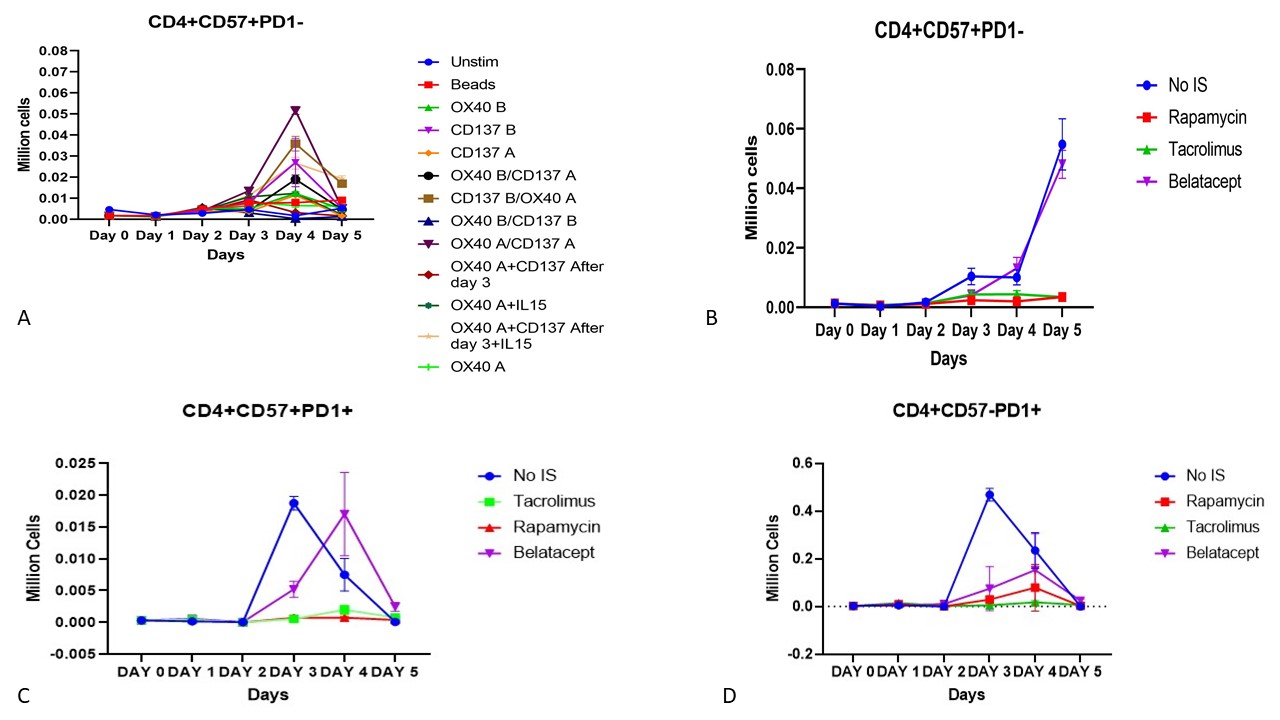Establishing a Linear Program for the Development of Costimulation Resistant T-Cells
Surgery, Duke, Durham, NC
Meeting: 2021 American Transplant Congress
Abstract number: 565
Keywords: Co-stimulation, T cell activation, T cells
Topic: Basic Science » Lymphocyte Biology: Signaling, Co-Stimulation, Regulation
Session Information
Session Name: Lymphocyte Biology: Signaling, Co-Stimulation, Regulation
Session Type: Poster Abstract
Session Date & Time: None. Available on demand.
Location: Virtual
*Purpose: CD4+CD57+PD1-T-cells are primed effectors capable of mediating belatacept-resistant rejection, however, the developmental program giving rise to these cells has not been elucidated in detail. We hypothesized that upon stimulation, naïve T-cells begin down an anticipatable path that progressively reduces their need for CD28-B7 costimulation and endows them with a phenotype of belatacept resistance.
*Methods: Peripheral blood mononuclear cells were cultured in vitro from healthy volunteers. Cultures were stimulated with Human 4-1BB/TNFRSF9/CD137 Antibody(10 ug/ml) and Human OX40 Ligand/TNFSF4 Protein, Fc Tag(10 ug/ml). Cells were also cultured in the presence or absence of interleukin 15(IL-15) and stimulated or non-stimulated with 4-1BB and OX40 costimulation. Immunosuppression such as tacrolimus(10ng/ml), rapamycin(10ng/ml) and belatacept(125ug/ml) was added on day 0 of the culture.
*Results: Cultures were exogenously stimulated with OX40 and CD137 before(B) or after(A) day 2. Exogenous IL-15 was administered after day 3. Conditions such as CD137B/OX40A and OX40A+CD137 after day 3+IL-15 were equally effective and generated the highest count of CD4+CD57+PD1- T-cells by day 5 (p<0.05 to all comparisons, Fig 1a). Stimulated cells with OX40A+CD137 After day 3+IL-15 demonstrated a rapid increase of CD4+CD57+PD1- cells after day 3 under belatacept, trend that was similar to the one found in the no immunosuppression group. Under tacrolimus and rapamycin treatment, the absolute counts of CD4+CD57+PD1 cells remained remarkable low (Fig. 1b). Similarly, CD4+CD57+PD1+ cells were also resistant to belatacept treatment but sensitive to tacrolimus and rapamycin effects(Fig. 1c). However, CD4+CD57- cells were sensitive to belatacept effect showing similar kinetics to those under tacrolimus and rapamycin(Fig. 1d).
*Conclusions: In this study it was shown that following TCR stimulation and appropriate costimulation, OX40 and CD137 play integral roles in the development of CD57+ cytotoxic CD4 T-cells. This maturation scheme is linear and anticipatable, and the movement from costimulation dependence to independence involves specific, time-dependent signals, which lead to tractable changes in surface molecule expression that may have prognostic and therapeutic value.
To cite this abstract in AMA style:
Moris DP, Lucander A, Kirk A. Establishing a Linear Program for the Development of Costimulation Resistant T-Cells [abstract]. Am J Transplant. 2021; 21 (suppl 3). https://atcmeetingabstracts.com/abstract/establishing-a-linear-program-for-the-development-of-costimulation-resistant-t-cells/. Accessed December 21, 2025.« Back to 2021 American Transplant Congress

